High-yielding Kuroda carrot with long shelf life
There are many varieties of carrots sold on the market today. The gardener can only choose based on his preferences and climatic features of the region.
The article will focus on the Kuroda variety - an unpretentious, productive and tasty vegetable, about its advantages and cultivation features.
The content of the article
Description of the Kuroda carrot variety
Kuroda carrots are consistently popular with vegetable growers - they ripen early, the seeds germinate well, they are unpretentious and well kept long time.
Origin and development
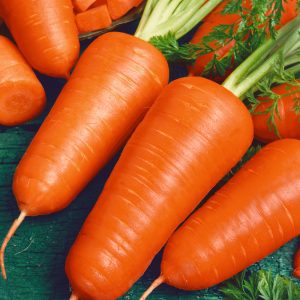
The homeland of the Kuroda variety is Japan, where in 2004 breeders of the Sakata company bred it on the basis of the popular French variety Shantane.
Since 2007, the variety under the full name Kuroda Shantane has been included in the state register of the Russian Federation.
Chemical composition, trace elements and vitamins, useful properties
Kuroda is a rich vegetable. The chemical composition includes various vitamins and nutrients that make the plant a wonderful anti-inflammatory, antiseptic, wound-healing and expectorant agent. The use of the root vegetable is recommended for anemia, bronchitis and other diseases.
Regular consumption of carrots facilitates the fight against fatigue, brittle nails, poor eyesight, weak immunity.
100 g of Kuroda carrots contains:
- carotene - up to 20 mg;
- sugar - up to 5 g;
- dry matter - up to 10 g.
Besides, carrots are valued for their high content of vitamins and minerals.
For 100 g of raw carrots there are vitamins:
- beta-carotene - 9 mg;
- vitamin E - 0.63 mg;
- vitamin C - 5 mg;
- pyridoxine - 0.13 mg;
- biotin - 0.60 mg;
- niacin - 1 mg;
- folic acid - 9 mcg;
- pantothenic acid - 0.26 mg;
- riboflavin - 0.07 mg;
- thiamine - 0.06 mg.
If we talk about micro- and macronutrients contained in carrots, then 100 g accounts for:
- boron - 200 mg;
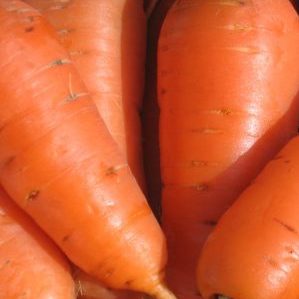
- aluminum - 325 mg;
- potassium - 199 mg;
- vanadium - 99.5 mg;
- chlorine - 63.3 mg;
- phosphorus - 56 mg;
- copper - 81 mg;
- fluorine - 54 mg;
- magnesium - 38.3 mg;
- calcium - 34 mg;
- sodium - 40 mg.
Nutritional value of carrots per 100 g:
| Content per serving | % of the daily value | ||
| Calories | 35 kcal | 2,23% | |
| Protein | 1.3 g | 1,38% | |
| Fats | 0.1 g | 0,14% | |
| Carbohydrates | 6.9 g | 4,83% | |
| Alimentary fiber | 2.4 g | 12% | |
| Water | 88 g | 3,16% | |
Ripening period
Kuroda is an early ripening variety. From germination to the first harvest, it takes about two months or a little more, it all depends on the weather conditions. After three months, it is ready for full cleaning.
Yield
Despite the short ripening period, the variety is high-yielding. Under normal growing conditions, from 1 hectare can be harvested from 23 to 42 tons of carrots.
Disease resistance
The Kuroda variety is distinguished by its stable immunity to the bulk of diseases. The culture is especially successful in resisting various types of rot.
Characteristics, description of appearance, taste
Kuroda carrots are distinguished by friendly seed germination and good marketability.The share of quality products ranges from 85% to 96% of the harvested crop. Root crops do not crack and do not go into the arrow. The variety, although it belongs to the early ripening variety, has high keeping rates.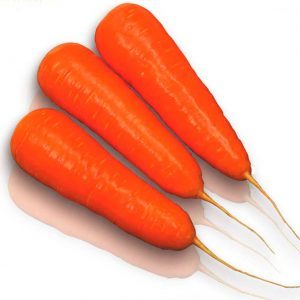
Growers appreciate the variety for its unpretentiousness to growing conditions and the environment.
The average size of a root crop is 15-18 cm, weight is from 90 to 160 g. Fruits are conical in shape with a blunt tip, bright orange in color. The pulp of the carrot is firm, tender and juicy, with a small pith.
The Kuroda variety has an excellent taste.
For which regions it is best suited and what is the exacting climate
The geography of growing Kuroda carrots is extensive. According to the state register of the Russian Federation, the variety is approved for cultivation in the North Caucasus. The culture has proven itself well in the northern regions, in the Moscow and Leningrad regions. Also suitable for breeding in Ukraine and Moldova.
The variety is adapted to any growing conditions and is quite cold-resistant; it can be sown throughout Russia.
Main advantages and disadvantages
The Kuroda variety is relatively young, but has already won love and trust thanks to its advantages:
- high productivity;
- sweet taste;
- high resistance to the vast majority of diseases and especially rot;
- long shelf life;
- tolerance to growing conditions: temperature changes, heat, dryness.
In the opinion of not only experts, but also amateur gardeners, no significant shortcomings were found in the variety.
What is the difference from other varieties
Compared to all other varieties of carrots, Kuroda stands out with a number of characteristics:
- high sugar and provitamin A content;
- juicy, wide core;
- significant size and straight shape;
- no tendency to accumulate solanine;
- a small number of lateral roots.
Features of planting and growing
Kuroda is quite unpretentious in cultivation, the process of sowing and care is no different from other varieties of culture.
Reference! The variety tolerates light frosts, so it makes no sense to sow it in a greenhouse.
Preparing for landing
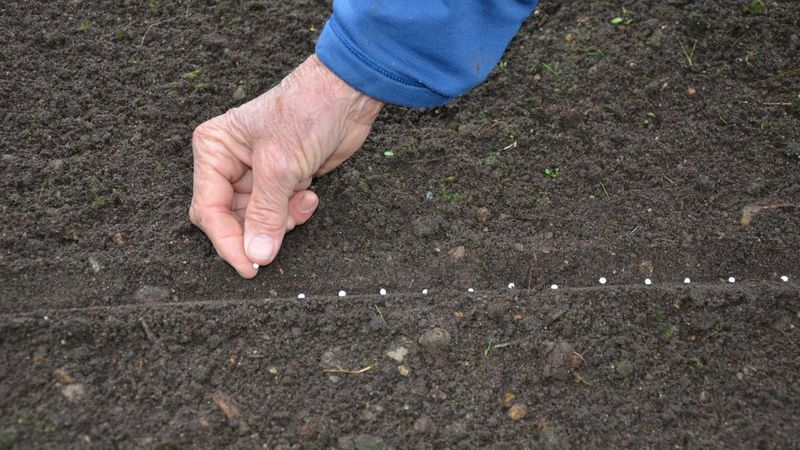
About a week before planting, the seeds are spread on a damp cloth and stored in a warm place, moisturizing from time to time. Such an operation accelerates the appearance of roots, the seeds germinate within 2-3 days.
You can soak the seeds for 12 hours in a light solution of potassium permanganate. This method will also increase their germination.
Ground requirements
Kuroda grows on any soil with a neutral PH (6-7)... But loams rich in humus are considered the best for growing carrots. If heavy soil prevails on the site, it is pretreated, that is, it is carefully loosened, without missing lumps and compaction, with the help of deep plowing they get rid of weeds and possible pests.
Predecessors
Experienced vegetable growers recommend making beds for carrots in those places where before her grew tomatoes, onions, garlic, lettuce, or early potatoes.
And vice versa, areas where umbrella or greens were previously planted will be suitable for carrots no earlier than four seasons.
Timing, scheme and landing rules
Kuroda is sown in the same way as other varieties of carrots. It is best to do this in well-moisturized soil.
The recommended landing pattern looks like this:
- the direction of the beds is north-south;
- the interval between rows is not less than 20 cm;
- the interval between adjacent root crops is 6-8 cm;
- the depth of the seeds is 1-2 cm.
If carrots are sown in April, then in the middle of summer it is already possible to harvest. In warmer regions, it is possible to harvest two carrots by sowing the seeds again in mid-July.
Kuroda can be sown before winter to get an earlier harvest.
Growing features
A sunny place is chosen for planting, the prepared seeds are sown directly into the ground. You can sow in any convenient way - with your hands in a row, on paper, with special devices that dispense seeds, etc.
Important! It is watered carefully, with a watering can with small holes so that the earth does not wash out.
The nuances of care
Caring for this carrot is not particularly difficult.
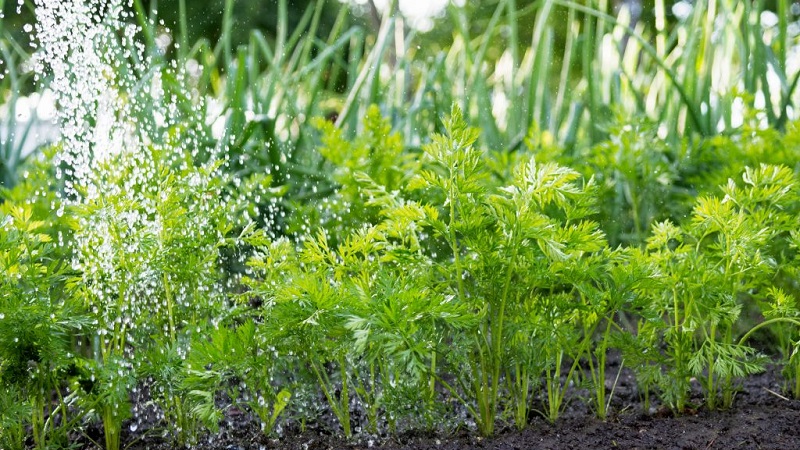
Water as needed. In rainy seasons, you can do without watering at all. If the summer is dry, watered once a week.
The variety is drought resistant and does not crack from lack of water.
Thinning and weed control
After the carrots rise, they are thinned out. Dense planting will affect the quality and presentation of the future harvest. During the season, you can carry out two thinning - when two leaves appear and when the root crops have already formed, but have not yet reached the desired size.
Weeding and harvesting of weeds is carried out as needed.
Top dressing
Top dressing is best done by changing organic and mineral fertilizers. During the season, no more than four dressings are carried out with a break of 2-3 weeks.
The first feeding is done three weeks after germination. 20 g of potassium sulfate and 30 g of superphosphate mixed with 5 g of urea are diluted in a bucket of water.
In another two weeks, a complex fertilizer for vegetables is used for feeding, for example, "Biohumus" (2 tablespoons of fertilizer per 10 liters of water). You can also feed with ash, it is scattered in the aisles and gently loosened.
Important! Organic fertilizers should not be used more than twice per season.
After another two weeks, potash and phosphorus fertilizers are applied.
Disease and pest control
Carrot pests and diseases spoil the appearance and taste of the plant.
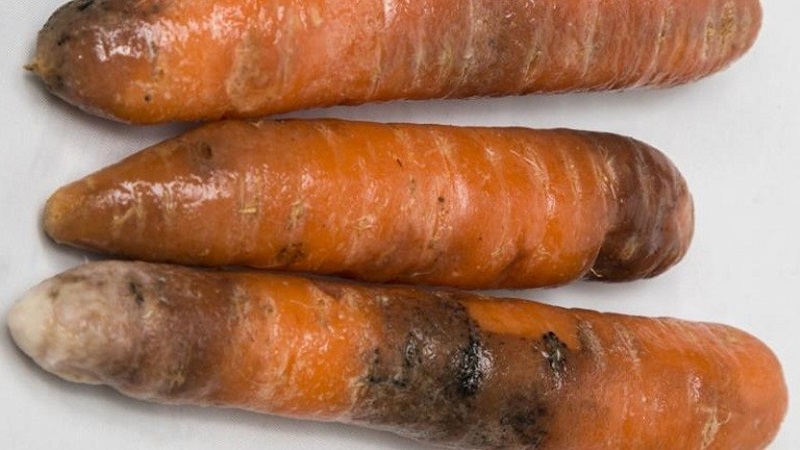
Diseases of carrots:
- dry rot - manifests itself in the form of brown spots on the root crop, which grow, forming voids;
- white rot - the fungus covers the root vegetable with a whitish bloom, the affected areas loosen, and the vegetable becomes watery;
- black rot - the tops darken, curl up and dry up, young seedlings can die en masse;
- powdery mildew - spoils the appearance of root crops.
To avoid infection, in the early stages of the growing season, they are treated with biological products of the fungicidal group, such as TNTD or Abita-PIK.
In addition to diseases, crop pests do great harm to carrots.
The main enemy of carrots is the carrot fly... It is indicated by the bronze shade of the tops. In the fight against the fly, the chemicals "Decis", "Arrivo" or "Aklellik" are used. Before sowing, the seeds are treated with special agents: "Azoto-fit", "Trichdermin" or "Phytocid-r". Deep plowing is used as a preventive measure. It kills pest larvae wintering in the ground.
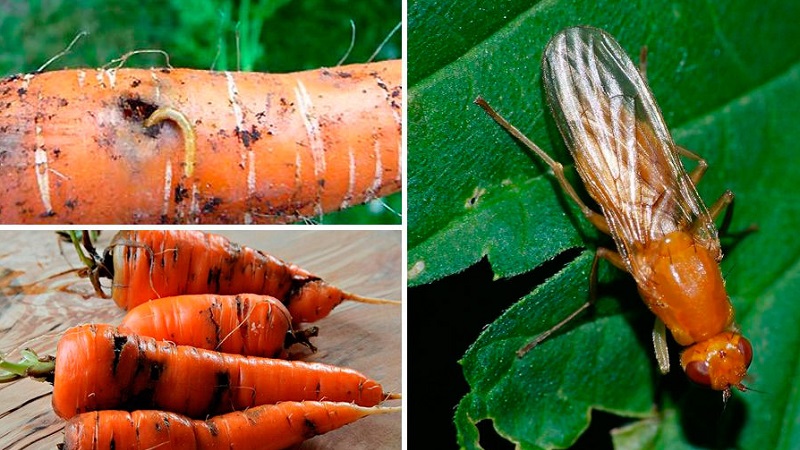
Harvesting and storage
Experienced gardeners do not recommend leaving carrots in the ground for more than the prescribed period, the vegetable can outgrow and lose its excellent qualities.
How and when to collect
Crop Kuroda can be harvested throughout the summer as it grows for fresh consumption and after the required ripening period (90 days) for winter storage.
Harvested in dry weather. The dug carrots should not be left in the sun for a long time, they will become soft in just a few hours. Do not leave the tops, it is removed completely from the root crop.
Storage features and keeping quality
Kuroda variety good kept... Optimum storage conditions of the variety: humidity - 85-95% and temperature - 0 ... + 2 ° С. It is better to store in boxes or baskets, sprinkled with wet sand.
There is also an alternative storage recipe: the top is cut off from root crops, the vegetables are washed, dried, then the carrots are laid out in portions in plastic bags, tied tightly and stored in a cool place - basement, cellar or refrigerator.
What can be the difficulties in growing
Kuroda is appreciated for its unpretentiousness and does not create any special problems for gardeners. The main thing is to follow the rules of agricultural technology and make sure that the plant is not attacked by pests and diseases.
Tips from experienced gardeners
Experienced vegetable growers who have been growing Kuroda carrots for more than one year recommend:
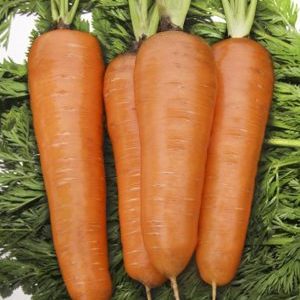
- To prevent carrots from cracking, in dry weather they are regularly spilled to a depth of 20-25 cm.
- In order for root crops to grow large and even, plantings are thinned out twice. The first time, an interval of up to 3 cm is left between the seedlings, the second - 5 cm.
- To protect carrots from carrot flies, marigolds or calendula are planted around the perimeter of the garden.
- A couple of times per season, carrots are fed with plant ash.
- Periodically, gently loosen the soil, trying not to touch the roots.
Reviews of Kuroda carrots
Almost all consumers note the excellent taste of the variety, high yield and good keeping quality.
Olga, Kazan: «It is not the first year that Kuroda carrots have been sowing, I always harvest an excellent harvest, store them in a cellar, and keep them well until spring. "
Natalia, Kirov: “My favorite carrot variety is Kuroda. I like keeping quality, juiciness. Lined carrots. Once I accidentally stayed in the garden in the winter, I also went “with a bang”. I plant the rest of the carrots in a bag, and this one - three at once.
Conclusion
Not only an experienced vegetable grower, but also a novice amateur gardener can grow and get an excellent harvest of Kuroda carrots. The variety is early, resistant to drought and frost. Plant before winter for an early harvest, or in the spring - and harvest your first carrots after two months. Follow our recommendations and the result will not disappoint you.